
Pros and Cons of Inflatable Paddle Boards - Is an Inflatable SUP Right for You?
Find out the pros and cons of the inflatable paddle board before you buy one.
Key Highlights
-
Unmatched Portability: Inflatable SUPs can be deflated, rolled up, and easily transported in a backpack or vehicle, offering unparalleled convenience for adventurers on the go.
-
Remarkable Durability: Made with military-grade PVC, these boards are tough against abrasions and impacts, perfect for exploring rugged coastlines.
-
Enhanced Stability: Their design provides a stable platform, making them suitable for beginners, yoga enthusiasts, and fishing activities.
-
Easy Storage: Deflated boards require minimal space, making them ideal for those with limited storage options.
-
Affordable and Accessible: Inflatable SUPs typically come at a lower price point than hardboards, making them a cost-effective entry into paddleboarding.
Transforming the World of Paddleboarding: The Unmatched Versatility of Inflatable SUP Boards
Welcome to the world of paddleboarding, a realm where adventure meets tranquility. At Glide, we're not just enthusiasts; we're pioneers dedicated to enriching your experience on the water. Today, we're diving deep into the revolution of inflatable paddle boards (SUPs) versus their traditional hardboard counterparts. Whether you're navigating the serene waters of a hidden lake or embarking on a coastal expedition, understanding the ins and outs of your gear is crucial.

Why Inflatable Paddle Boards are Making Waves
Imagine the freedom of exploring distant waterways without the bulk. Inflatable SUPs offer unparalleled portability, transforming from a compact bundle into a full-sized board in minutes. Gone are the days of wrestling with a rigid board; your next adventure fits snugly in the trunk of your car, ready to unfold at a moment's notice.
But it's not just about convenience. These boards are crafted from military-grade PVC, ensuring they can withstand encounters with rocky shores and remain unfazed by the sun's relentless rays. This durability doesn't just promise longevity; it brings peace of mind as you paddle through life's adventures.
For those new to the sport or looking to expand their playground, the stability of an inflatable SUP is a game-changer. Their design offers a supportive platform for yoga enthusiasts and anglers alike, while still catering to the thrill-seekers looking to ride the waves. Plus, their generous weight capacity means you can bring along your furry friend or pack extra gear for a day on the water.
And let's talk value. Inflatable SUPs present an attractive price point without compromising on quality. They're not only an initial investment into your health and happiness but also a long-term companion that avoids the frequent upkeep associated with hardboards.
Addressing the Myths: Performance and Maintenance
Some may question whether an inflatable SUP can match the performance of a rigid board. It's true, the essence of paddleboarding is in the glide and maneuverability. However, innovation has narrowed this gap significantly. Many inflatable SUPs now boast designs that cater to speed and agility, ensuring that enthusiasts can still enjoy the thrill of slicing through water or executing a sharp turn.
Preparation and maintenance are part of any sport, and paddleboarding is no exception. Yes, inflating your SUP requires a few extra minutes of setup, but consider this a small investment in your journey towards serenity or adventure. With electric pumps readily available, getting your board water-ready is easier than ever.
When the day is done, caring for your inflatable SUP ensures it's ready for your next outing. A simple rinse and dry safeguard against mildew, a small step that maintains the integrity of your board. This minor routine pales in comparison to the joy each journey brings.
Inflatable SUPs: The Future of Paddleboarding

As a member of the Glide family, I've witnessed the transformative impact of inflatable SUPs on our community. They democratize paddleboarding, making it accessible to city dwellers and adventurers alike. Their resilience challenges the traditional limitations of exploration, inviting us to dream bigger and go further.
Choosing an inflatable SUP isn't just about selecting a board; it's about embracing a lifestyle. A lifestyle that values freedom, adventure, and the unparalleled connection with nature that paddleboarding provides.
In closing, the evolution of inflatable paddle boards symbolizes more than technological advancement; it reflects a growing community of explorers, dreamers, and environmental stewards. At Glide, we're not just selling boards; we're inviting you to join a movement that celebrates the great outdoors and propels you towards your next adventure.
Your journey awaits. Are you ready to redefine the limits of paddleboarding?


